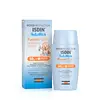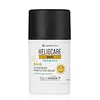What's inside
What's inside
 Key Ingredients
Key Ingredients

 Benefits
Benefits

 Concerns
Concerns

 Ingredients Side-by-side
Ingredients Side-by-side

Water
Skin ConditioningDicaprylyl Carbonate
EmollientDiethylhexyl Carbonate
EmollientCyclopentasiloxane
EmollientDibutyl Adipate
EmollientTitanium Dioxide
Cosmetic ColorantZinc Oxide
Cosmetic ColorantAlcohol Denat.
AntimicrobialCyclohexasiloxane
EmollientButylene Glycol
HumectantPEG-30 Dipolyhydroxystearate
EmulsifyingNylon-12
Dimethicone
EmollientPEG-10 Dimethicone
Skin ConditioningSodium Chloride
MaskingSilica
AbrasivePhenoxyethanol
PreservativeDisteardimonium Hectorite
StabilisingAllantoin
Skin ConditioningGlyceryl Stearate
EmollientTocopheryl Acetate
AntioxidantTriethoxycaprylylsilane
Disodium EDTA
Sodium Hyaluronate
HumectantEthylhexylglycerin
Skin ConditioningPEG-8
HumectantTocopherol
AntioxidantAscorbyl Palmitate
AntioxidantAscorbic Acid
AntioxidantCitric Acid
BufferingWater, Dicaprylyl Carbonate, Diethylhexyl Carbonate, Cyclopentasiloxane, Dibutyl Adipate, Titanium Dioxide, Zinc Oxide, Alcohol Denat., Cyclohexasiloxane, Butylene Glycol, PEG-30 Dipolyhydroxystearate, Nylon-12, Dimethicone, PEG-10 Dimethicone, Sodium Chloride, Silica, Phenoxyethanol, Disteardimonium Hectorite, Allantoin, Glyceryl Stearate, Tocopheryl Acetate, Triethoxycaprylylsilane, Disodium EDTA, Sodium Hyaluronate, Ethylhexylglycerin, PEG-8, Tocopherol, Ascorbyl Palmitate, Ascorbic Acid, Citric Acid
Coco-Caprylate/Caprate
EmollientDicaprylyl Carbonate
EmollientBis-Ethylhexyloxyphenol Methoxyphenyl Triazine
Skin ConditioningDiethylamino Hydroxybenzoyl Hexyl Benzoate
UV FilterDibutyl Lauroyl Glutamide
Skin ConditioningDiethylhexyl Butamido Triazone
UV AbsorberEthylhexyl Triazone
UV AbsorberDibutyl Ethylhexanoyl Glutamide
Skin ConditioningEthyl Vanillin
MaskingPolypodium Leucotomos Leaf Extract
Skin ProtectingTocopherol
AntioxidantDiethylhexyl Syringylidenemalonate
Skin ProtectingCaprylic/Capric Triglyceride
MaskingHaematococcus Pluvialis Extract
AntioxidantPropylene Glycol
HumectantMaltodextrin
AbsorbentLecithin
EmollientSilica
AbrasiveAscorbyl Palmitate
AntioxidantRosmarinus Officinalis Flower/Leaf/Stem Extract
MaskingCoco-Caprylate/Caprate, Dicaprylyl Carbonate, Bis-Ethylhexyloxyphenol Methoxyphenyl Triazine, Diethylamino Hydroxybenzoyl Hexyl Benzoate, Dibutyl Lauroyl Glutamide, Diethylhexyl Butamido Triazone, Ethylhexyl Triazone, Dibutyl Ethylhexanoyl Glutamide, Ethyl Vanillin, Polypodium Leucotomos Leaf Extract, Tocopherol, Diethylhexyl Syringylidenemalonate, Caprylic/Capric Triglyceride, Haematococcus Pluvialis Extract, Propylene Glycol, Maltodextrin, Lecithin, Silica, Ascorbyl Palmitate, Rosmarinus Officinalis Flower/Leaf/Stem Extract
 Reviews
Reviews

Ingredients Explained
These ingredients are found in both products.
Ingredients higher up in an ingredient list are typically present in a larger amount.
Ascorbyl Palmitate is created by combining pure Vitamin C and palmitic acid. It is an antioxidant and helps reduce hyperpigmentation.
This ingredient is a more stable version of Vitamin C, meaning it does not disintegrate as quickly when exposed to sunlight. However, studies show it does not penetrate skin as well as pure Vitamin C.
Ascorbyl Palmitate is oil soluble.
Read more about other types of Vitamin C:
Learn more about Ascorbyl PalmitateDicaprylyl Carbonate comes from carbonic acid and caprylyl alcohol, a fatty alcohol. It is an emollient and gives skin a velvet feel. The sources of Dicaprylyl Carbonate may be synthetic or from animals.
As an emollient, Dicaprylyl Carbonate creates a film on the skin. This film traps moisture in, keeping your skin soft and hydrated.
Silica, also known as silicon dioxide, is a naturally occurring mineral. It is used as a fine, spherical, and porous powder in cosmetics.
Though it has exfoliant properties, the function of silica varies depending on the product.
The unique structure of silica enhances the spreadability and adds smoothness, making it a great texture enhancer.
It is also used as an active carrier, emulsifier, and mattifier due to its ability to absorb excess oil.
In some products, tiny microneedles called spicules are made from silica or hydrolyzed sponge. When you rub them in, they lightly polish away dead skin layers and enhance the penetration of active ingredients.
Learn more about SilicaTocopherol (also known as Vitamin E) is a common antioxidant used to help protect the skin from free-radicals and strengthen the skin barrier. It's also fat soluble - this means our skin is great at absorbing it.
Vitamin E also helps keep your natural skin lipids healthy. Your lipid skin barrier naturally consists of lipids, ceramides, and fatty acids. Vitamin E offers extra protection for your skin’s lipid barrier, keeping your skin healthy and nourished.
Another benefit is a bit of UV protection. Vitamin E helps reduce the damage caused by UVB rays. (It should not replace your sunscreen). Combining it with Vitamin C can decrease sunburned cells and hyperpigmentation after UV exposure.
You might have noticed Vitamin E + C often paired together. This is because it is great at stabilizing Vitamin C. Using the two together helps increase the effectiveness of both ingredients.
There are often claims that Vitamin E can reduce/prevent scarring, but these claims haven't been confirmed by scientific research.
Learn more about Tocopherol